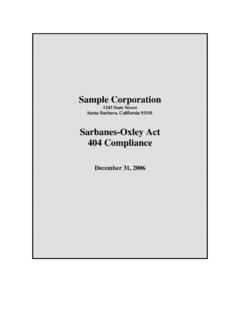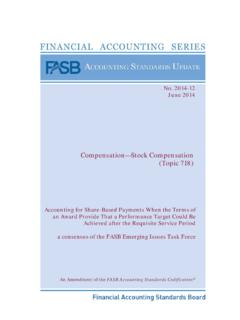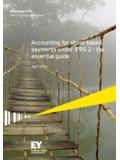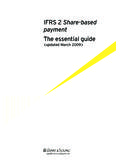Transcription of FAS123r Stock Option Accounting White Paper
1 2007 ProCognis, Inc. All Rights Reserved 1 of 8 November 2005 FAS123r Stock Option Accounting White Paper Accounting Treatment for Stock options : Option Valuation and Model Selection Author: Lynda Radke, CPA ProCognis, Inc. Abstract This discussion summarizes the newly revised FAS123r treatment for expensing of Stock options . The coverage includes the two most common Option valuation models: Binomial Lattice and Black Scholes Merton. The Paper concludes with an analysis of the models along with a discussion of their practical application. 1. Stock Option Treatment Background FAS123 Share Based Payments was revised in December of 2004.
2 The new standard, known as FAS123r requires the expensing of employee Stock options over the implied service term: the period over which the grantee earns the Option grant. Historically, employee Stock options fell under the guidance of APB Opinion No. 25, Accounting for Stock Issued to Employees . [1] APB No. 25 used the intrinsic value approach, which only required an expense be recorded if the grant had intrinsic value: a strike price lower than the current market price of the Stock on the date of grant. Many shareholder activists sought to have all options expensed. Businesses actively lobbied against such a provision due to the perception that the expense treatment would be potentially onerous.
3 In the end, a compromise was reached and the FASB issued the original FAS No. 123, Accounting for Stock Based Compensation . While it encouraged expensing, it did not specifically require it. It did require that all companies determine the fair market value of their Stock options at grant date. However, it allowed the Company to choose between expensing the value of the options under FAS123 or disclosing what that amount would have been and continue to record options under the intrinsic value method. Not surprisingly, most companies chose to continue using the intrinsic value method. Under this method they had to calculate the fair value, but the amount was only used in the footnotes.
4 As the fair value method was used for disclosure only, few companies invested significant resources in building complex valuation models. In fact, most companies chose to use a modified version of the Black Scholes Merton ( BSM ) model. This model was easy to implement using formulas widely available on the Internet, in trade publications or through auditing firms. The downside was that because of its simplicity it often produced valuations that lacked precision. [2] 2007 ProCognis, Inc. All Rights Reserved 2 of 8 However, the issue of expensing Stock options was not resolved. Shareholder activists continued to advocate for the full expensing of the calculated fair value of Stock options .
5 And many analysts complained that the choice between expensing and disclosing created inconsistencies between companies selecting differing treatment which hampered their analysis. During the high growth late 90s, companies felt free to issue large Stock grants as an effective way to attract and retain the best and brightest. While there were always some rumblings of discontent, rising Stock prices subdued the dissent. However, once the Stock bubble burst the discontent boiled over with the high profile implosions of Enron, WorldCom and countless others. Suddenly, large Option grants came under intense scrutiny.
6 In a few well publicized cases, company executives had exercised and profited from their options shortly before their once mighty companies tumbled into financial ruin. Proponents of expensing Stock options came out swinging and the battered business community was in no position to oppose them. The result was FAS No. 123r, Share Based Payments , a re issuance of the existing Accounting standard. The re issuance removed the choice to continue using the intrinsic method. The end result is that companies that issue Stock options will now have to record an expense for what they had previously only had to disclose.
7 They are also required to record expense for any outstanding unvested options . 2. FAS123r Requirements FAS123r requires that costs resulting from all share based payment transactions be recognized in the financial statements. It also established fair value as the measurement objective. The FASB has been gradually establishing the fair value Accounting approach over the last decade, supplanting historical cost treatment. As a result, companies will be required to use a fair value based measurement method to account for employee Stock options . The FASB stopped short or requiring a specific model (they considered requiring the use of a binomial or lattice technique, see below) and even left the door open for the development of new models.
8 [3] To meet the criteria, the model must at minimum take into consideration the following criteria: Volatility, Expected Term and Risk Free Rate of Return. Companies certainly can continue to use the BSM. However, now that expensing is required, they should carefully consider the appropriateness of both the model and their inputs to that model. Fair-Value vs. Historical Cost Accounting FAS123r is another step towards fair-value Accounting and away from the historical cost method. A number of recent pronouncements have demonstrated FASB s preference for the fair-value methodology.
9 2007 ProCognis, Inc. All Rights Reserved 3 of 8 In addition, FAS123r no longer permits companies to account for forfeitures as they occur. Companies will be required to estimate their forfeiture rate and record expense net of estimated forfeitures. FAS123r Terminology Volatility: the amount of up or down price movement of the Stock that underlies the Option or warrant. Contractual term: the period of time that the grant could potentially remain in effect due to the contractual terms of the Option grant. Expected Term: the term that an employee share Option or similar instrument is expected to be outstanding.
10 This term is generally shorter than the contractual term of the grant. Used as an input to Black Scholes but computed through the Binomial model. Risk Free Rate of Return: the annual interest rate a risk free investment could potentially earn during the expected term of the Option grant. This rate is used to present value the Option grant valuation for future potential exercise. Sub Optimal Stock Price: the price that the underlying shares of the Option grant must exceed before the Binomial or Trinomial lattice models will consider the Stock to be exercised. This Stock price is generally a multiple of the strike price.







